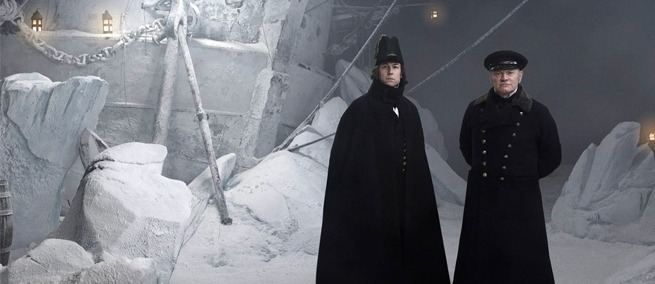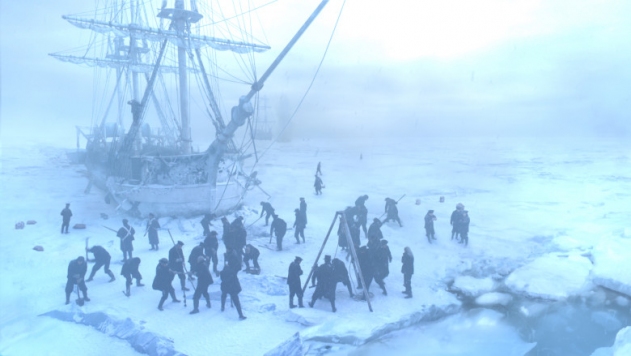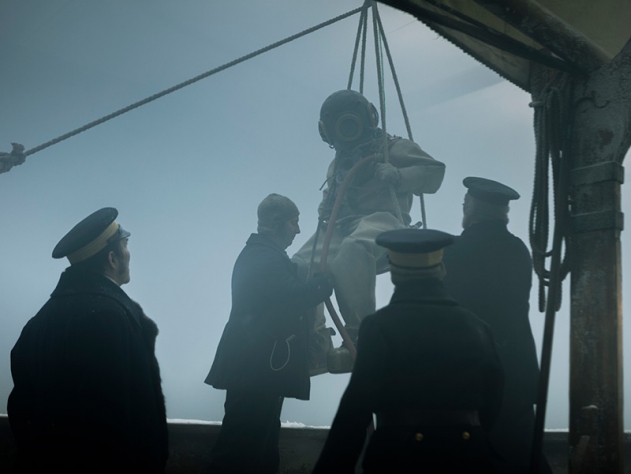
The new AMC original historical drama series THE TERROR is based on an 1845 British Royal Navy expedition to the Arctic that never returned. Over 100 men set sail on two ships—The Terror and The Erebus—searching for the Northwest Passage, which would open up a trade route between Europe and Asia. Veteran polar explorer, Sir John Franklin, led the expeditions. The Terror and Erebus seemed to have vanished, the entire crew dead, until the ships were discovered in 2014 and 2016 in near-pristine condition. THE TERROR is a fictionalized account of what happened to the expedition crew, including their ships becoming icebound, unfriendly encounters with the Inuit, a paranormal creature that stalks their camp, mass lead poisoning, and ultimately cannibalism.
THE TERROR is adapted from Dan Simmons’ horror novel of the same name. It is ten episodes, now available on Blu Ray, and stars Jared Harris (THE CROWN), Tobias Menzies (GAME OF THRONES), Adam Nagitis (HAPPY VALLEY), Nive Nielsen (THE NEW WORLD), and Ciarán Hinds (ROME). David Kajganich and Soo Hugh were showrunners, and Max Borenstein, and Alexander Woo developed the show. It Is written by Kajganich, Andres Fischer-Centeno, Josh Parkinson, and Vinnie Wilhelm. It is produced in part by Ridley Scott’s Scott Free Productions. THE TERROR is an anthology, and has just been renewed for a second season which will focus on a west-coast Japanese-American community during World War II.
THE TERROR was developed with the help of a historical advisor, Matthew Betts, who is an archaeologist and curator at the Canadian Museum of History. He is an amateur modeler who built a 1:48 scale model of The Terror and documented it online; this led THE TERROR’s showrunners to contact him go serve as historical advisor. Science & Film spoke with Betts on the phone from his home in Canada.
Science & Film: How did you become interested in The Terror and The Erebus?
Matthew Betts: I am an archaeologist, and my PhD was in the archaeology of the Inuit. I’ve always been interested in the Franklin expedition and the history of contact between Europeans and Inuit but, despite the opportunity, it never became part of my career. But for the last 10 years or so, I’ve been building ship models. Building historic ships combine my love of woodworking and model building with my meticulous nature and love of research. Five years ago, I was looking for a new project and thought, I know they’re looking for [The Terror and Erebus] so that might be an interesting project. I started doing some research and realized that there actually wasn’t a lot known about the ships. There were a lot of gaps in knowledge about how these ships were constructed and what they were capable of; I wanted to know everything about how these ships were constructed, why they were so special, why they were chosen for the incredible voyages they went on. I wanted to build a high quality, accurate model of these vessels, and realized nobody had even tried to develop plans for them. That led to a five-year journey of me constructing The Terror. It was that sort of organic.
The quarterdeck on Matthew Betts' Terror model. Photo Credit: Matthew Betts.
I started by drawing plans; I took the originals from the National Maritime Museum and then modified those extensively based on research. I was learning so much that I started blogging about it. Then they discovered The Erebus in 2014, and everything took off from there. It’s been a bit of a roller coaster. It was supposed to be just a private modeling project, corresponding with some other modeling nerds online, and it became a much bigger thing.
S&F: Could you explain what was so unique about these ships?
MB: The ships were originally designed as bomb vessels. Terror is actually famous for another reason: it attacked the United States during the War of 1812, lobbing bombs at Fort McHenry in Baltimore—if you can believe it, the “bombs bursting in air” in the “Star Spangled Banner” are the bombs that were lobbed by Terror. It’s quite a famous ship. Then, it was laid up in ordinary (editor’s note: in ordinary is a British navy term for ships that are out of service). Bomb vessels are very strongly built vessels: the recoil is so extreme that they had to be strong. They also have massive holds designed from merchant vessels, and the big holds were necessary to store all the bombs. So they were very good for conversion to polar exploration because they had massive holds so could store what people would need, and are also very strong so if trapped in the ice they could withstand that.
The ships were converted to polar service, their hulls were double-planked, a host of other avant-garde technologies were crammed into them, then at the end of their life in 1845, just before they were set on their final voyage, one further modification was added. A portion of the upper deck was removed and they literally lowered a steam locomotive engine into the holds of the vessels and then extended the axel of the locomotive engine through the stern and then attached a propeller to the end of the axel. That’s how they converted the vessels to steam locomotion. There were screw-powered vessels previously, but very few Royal Navy vessels had been converted this way to steam locomotion. This was one of the first conversions ever conducted by the Royal Navy to change a ship to steam locomotion.

S&F: You said it was a locomotive engine that they used. Does that mean it was from an actual train?
MB: They literally took a used locomotive engine from the Croydon line off the rails and dropped it into the ship. This was experimental, but the conversion worked and they were able to get the ships to go about four knots per hour. The episode in THE TERROR in which they’re talking about the locomotive engine didn’t really address this, but the engines were only supposed to be used during the dead calm. You could use the locomotive engine when you couldn’t power the vessel by sail, or if the winds were contrary—blowing in your face. They were meant to be auxiliary, just to save the crew time so they wouldn’t have to beat up into the wind or so they wouldn’t waste time waiting for wind to come.

From The Terror set, the locomotive engine that wass reconstructed at full scale. Photo Credit: Alex Eldridge.
S&F: There is a great scene in the first episode of the naval officer being lowered into the water on what looks like a swing, wearing this huge diving suit. Was that based on real technology from the time, and do you know if they had it on Terror?
MB: The wax canvas suit with big heavy boots on the show was based on a real suit from that era. This was a relatively new technology that had been around for only ten years, but hadn’t seen much adoption in the Royal Navy. We have no evidence that one of these suits was on Erebus or Terror, it was an accommodation for the script; they wanted to show the screw propeller and also how the ships might have been disabled. When we realized that this technology did exist at the time, we raised the question of: why didn’t the Royal Navy use these really impressive pieces of technology to help them repair their ships while they were at sea? [The way it worked,] there would have been a bellows on the deck and people would have been pumping fresh air into the suit at all times. The diver would have relied on weights to bring him down. The bosun’s chair is a real thing that was used to lower people into the water. In real life, repairing a propeller damaged by ice would have been a harrowing proposition. Maybe somebody would have had to dive without a suit.
S&F: Who were the main people you worked with on THE TERROR?
MB: I worked with a large portion of the crew. Just like I say on my blog, it all started with an email. I was happily doing my blog, and after they found Erebus I had a little bit of a reaction; the Canada Post contacted me and I helped them make an international stamp [with an illustration of Erebus’ deck combined with a sonar image of the actual ship]. I had known that THE TERROR was coming and was watching with interest when all of a sudden I got an email from one of the showrunners, David Kajganich. I immediately told my wife, you’ll never guess who I just got an email from! It was a very wonderful, polite email saying that they were fans of my blog and asking if I’d be interested in talking to them about how to bring this ship and time period to life, and if I wasn’t interested just to know that they were fans. It all started with a telephone conversation with Dave and Soo [Hugh], and a few of the writers. We got together and discussed important areas of the ship that might be useful in a dramatic story.
I worked with many facets of the production design, with the writers, and I produced a little document of different interesting areas of the ship where there might be some drama—there were about a dozen areas I wrote little notes on for the writers. Then, I was put in touch with Jonathan McKinstry—the production designer—and the VFX team, and we discussed how to accurately bring these ships to life. Then started the intensive six month process where we would discuss what sets they were going to build and how they were going to look, and either I would draft new plans or find similar images or paintings to help them design the sets, and we’d go back and forth. It was pretty iterative. They would say, what would this piece of furniture look like? I enjoyed it immensely. My role expanded over time, and I became involved in researching all the material culture of the ship—everything from caulker’s tools and the seaman’s chest, to the dinner plates and the tent poles. We maxed out the capacity on our Dropbox regularly with all the images we were sharing.

S&F: How do you think the show turned out?
MB: Dave and Soo, I consider them both to be just extreme geniuses. Even though this was a fictional account of the Franklin expedition, their dedication to getting the material culture right was really inspiring. As an archaeologist and an amateur historian, it was important to me that the ships looked right and that the material culture was right because I saw the two ships as characters in the story. For the first eight episodes, their capabilities and spaces really drive all the drama in the story. [The show’s creators] could have gone away from historical accuracy and made THE TERROR as gothic as they wanted to, but they didn’t do that. They kept it very historically accurate, even to the point where the bolt holes in the ship are in the same spots as they would have been. The only real modification was to make the ship’s decks on the show a few centimeters higher so the actors wouldn’t always be bumping their heads. The cabins were all the same size as they were originally, which was actually much smaller than a prison cell, even though it was difficult to film in them. You barely even saw it in the series, but they reconstructed the entire locomotive engine and all the ships’ water tanks. It all adds to this layered authenticity that’s really important to the show.
S&F: I like what you said about the ship being a character. I felt that. So much of the physicality of it drives the plot.
MB: Absolutely. The area where the sick bay was is accurate to the original plan. We spent a lot of time getting that area right. The wonderful production designers, they’re all engineers in a way and they figured things out how things were arranged or supported that turned out to be true when I saw the real pictures of Terror. The real ship is sitting there pristine, under the waves in Terror Bay. It was pretty incredible. My first time on the ship I had a flashlight and we were poking through. I was one of the first people to see what it looked like.
S&F: What happened to the ships, in real life?
MB: The actual Terror was found September 2016 and this isn’t hyperbole, it was found in almost pristine condition. It is probably one of the best-preserved shipwrecks in the world. The only thing that did real damage to it was a mast falling. The show’s writers had written the script before the ship was found; despite the fact that THE TERROR has a supernatural predator, the writers wanted to be as accurate as possible so they had to accommodate ideas [from the discovery]. Terror was found in a position much further south than they thought it would be. When I wrote about it Dave I thought, this is going to ruin their show. He wrote back immediately. This is how invested in history he is, they re-wrote the script to accommodate the discovery of the vessel. Parks Canada is involved in the research on that vessel, and they very kindly invited me to their lab to have a look. Terror is incredibly well preserved. According to them, the jury’s still out on how it got there. There are two options: it could have floated there, or it could have been piloted there. The only way to know is once they get inside the ship, to look for evidence of occupation and re-manning. Hopefully there’ll be some preserved journals, logs, and perhaps even letters they can access.
S&F: So that’s still in process?
MB: Yeah. In the images we’ve seen, dining plates are still on the shelves. The rope on the deck is still coiled tightly in spiral Royal Navy fashion. It’s an absolutely incredible snapshot of Royal Navy life in a dire situation in the middle of nowhere.
S&F: As a scientist having worked on this popular television show, what are your thoughts about the impact the show has had on public interest in this part of history?
MB: It has had a seismic impact. There has been a rather fervent and active community of people that are really interested in the Franklin expedition and there are a lot of scholars who are devoted to this. But most of them are academic, and the circle was quite insular. There is a Facebook group called “Remembering the Franklin Expedition,” and there are great researchers. But after THE TERROR, hundreds of thousands of people have become amateur Franklin researchers. There’s a Facebook group with thousands of fans rabid for information on this expedition. I don’t know how to explain other than to say it’s been a seismic wave of interest that has swept North America and Europe. Of course in the UK, these are Royal Navy vessels and crews, but a lot of people in the UK didn’t even know about this. It is very important for Canadians because of the resulting contact with the Inuit and mapping of the North, but in the UK the expedition was not as well known as other Royal Navy expeditions. Now, it’s extremely well known.

S&F: I wish there were two seasons about Terror!
MB: That’s what a lot of people are saying; they wish it had been drawn it over two seasons. Although, to be completely honest, I had read Dan Simmons’ novel but I had no idea that there was interest in making it into a TV show or a production of any kind, so the idea that we have ten full hours exploring this history is a dream come true. THE TERROR team built these ships on a one-to-one scale. We actually got to walk their decks. I got to play a naval seaman at one point in the show. I’m a scientist and a researcher but to stand on deck of the ship I’d been dreaming about over the past five years, there was a boyish thrill to be on the real ship and imagine what it was like for these men.
Dave Kajganich, Jonathan McKinstry, and Matthew Betts stand on the set of The Terror. Photo Credit: Matthew Betts.
AMC’S THE TERROR is now available on Blu-ray. All ten episodes can also be streamed on Amazon Prime. The series has been renewed for a second season, which will air in 2019. Matthew Betts’ blog, “Building HMS Terror” documents his models, the show’s production, and the historical references which he and the team used.
TOPICS